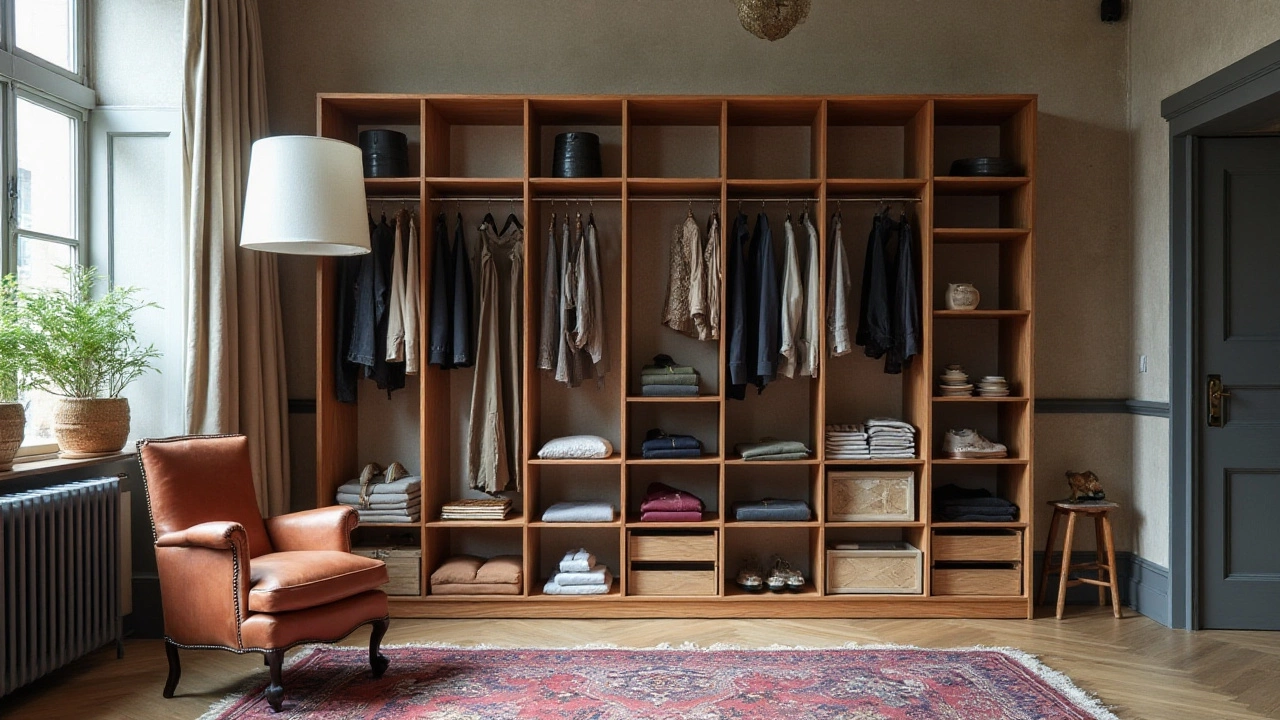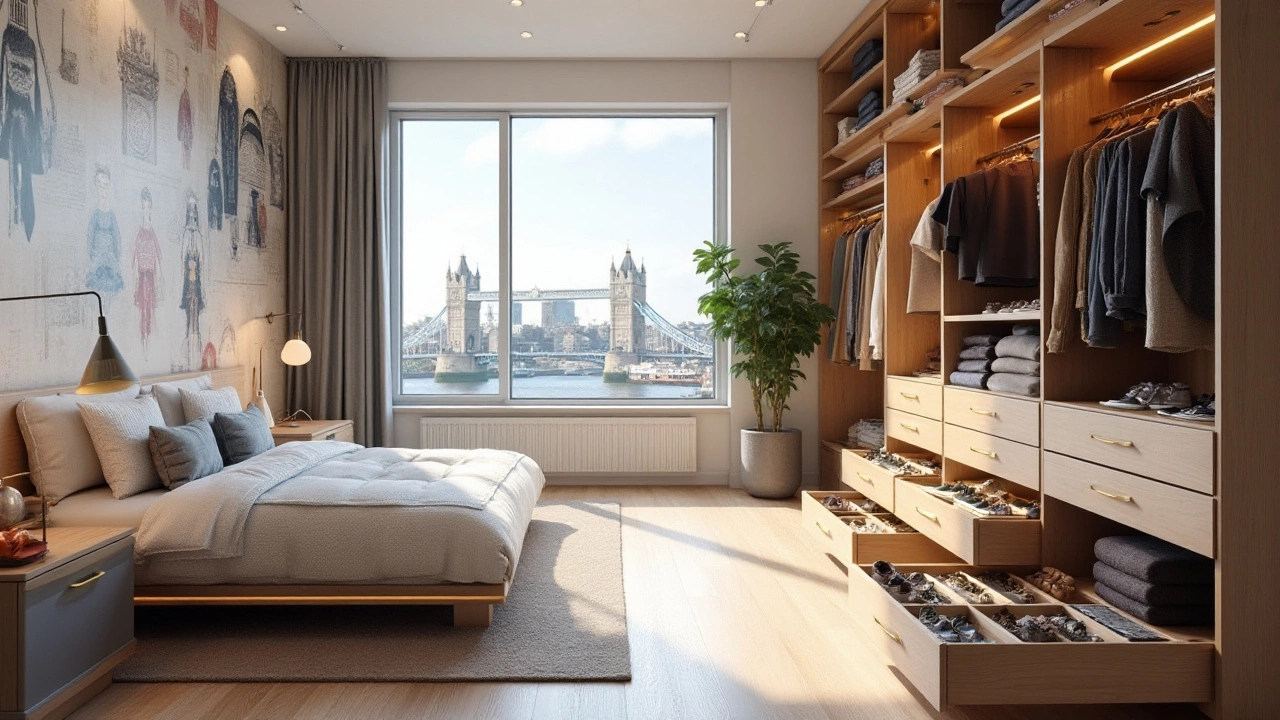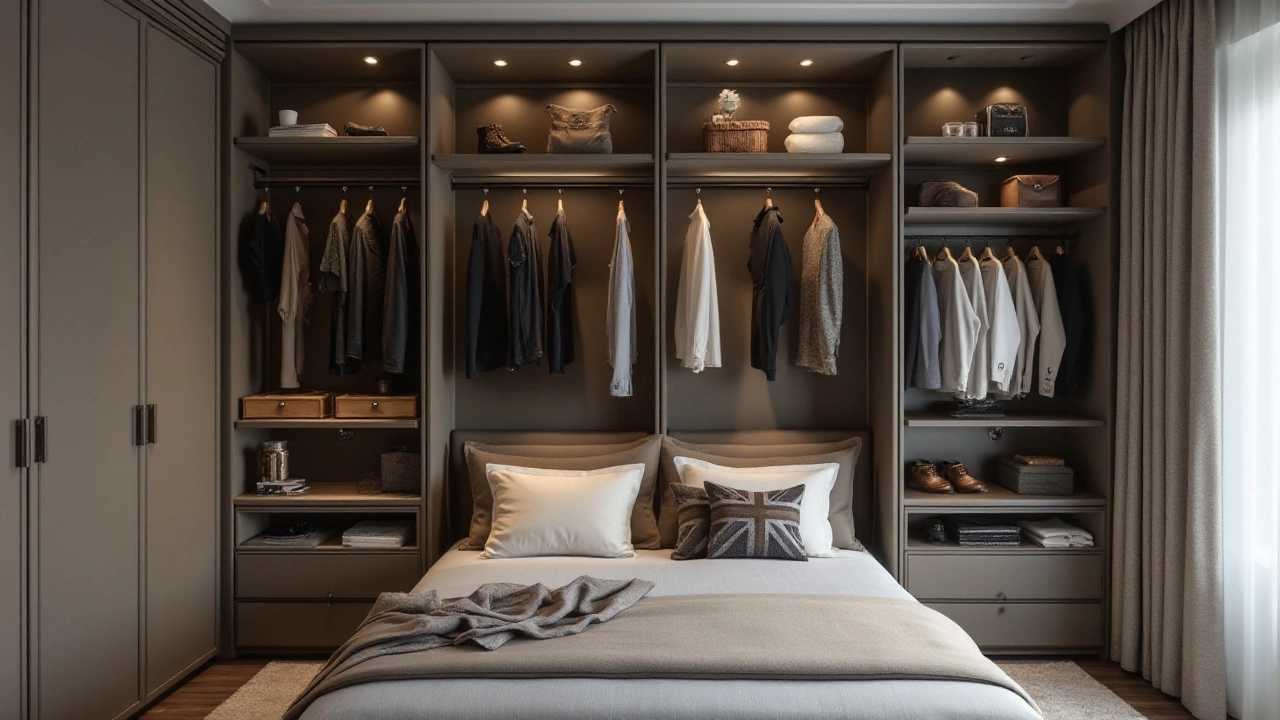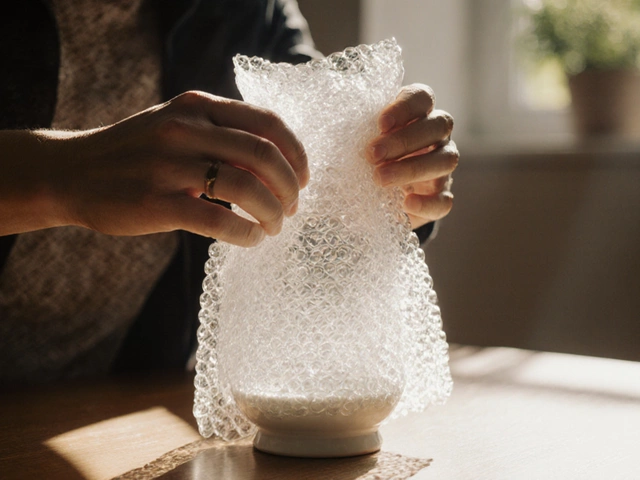For many, the word 'wardrobe' might conjure images of grand, wooden cabinets filled with luxurious garments, but the world of furniture is as dynamic as the changing times. As lifestyles evolve, so too does the language we use to describe essential items in our homes. The wardrobe, while timeless in function, has seen linguistic and design transformations.
Today, we explore various names and styles that provide fresh takes on this staple furniture piece. Whether you're revamping your bedroom or simply indulging in a bit of design curiosity, understanding these contemporary terms and trends can make your space feel more personalized and up-to-date.
- The History of the Wardrobe
- Modern Synonyms for Wardrobes
- The Role of Language in Furniture Design
- Cultural Influences on Storage Solutions
- Exploring Alternative Wardrobe Designs
- Choosing the Right Wardrobe for Your Space
The History of the Wardrobe
The story of the wardrobe is as rich and varied as the garments it has housed over the centuries. Originating as far back as the medieval times, the term 'wardrobe' itself derives from the Old French words ‘warder’, meaning ‘to guard’, and ‘robe’, meaning ‘garment’. In ancient castles, the wardrobe was not just a piece of furniture but a room where the most precious robes and linens were stored and meticulously cared for by attendants. These early versions were less about furniture and more about entire chambers devoted to clothing protection.
Moving into the Renaissance period, the wardrobe began its transformation from room to furniture. As European society grew wealthier and more conscious of personal possessions, the need for dedicated storage solutions within homes became apparent. Major shifts in society and culture led to the evolution of bespoke, standalone wardrobe designs. A notable leap occurred in the 17th century when elaborate French Louis XIV armoires, characterized by their ornamental designs and fine craftsmanship, popularized the concept of wardrobes as sophisticated furniture pieces. These creations set the standard for what a wardrobe could be, both in functionality and aesthetic appeal.
Fascinatingly, the Industrial Revolution marked another significant turning point in the wardrobe's evolution. With the rise in middle-class affluence and mass production capabilities, wardrobes became more accessible to the average household. No longer reserved for the elite, these furniture pieces began to fill bedrooms across the globe, crafted in various styles to match the changing trends in home decor. Today, they are essential in planning efficient clothing storage systems. Sizes and styles adjusted with the expanding possibilities, and regions added local flavors to designs, showing cultural differences in methods for organizing personal belongings. Access to different materials also diversely influenced wardrobe transforms.
"The wardrobe, much like an old friend, adapts to the seasons of our lives and the stories we choose to live," reflects interior designer Jonathan Adler, highlighting the wardrobe's timeless relevancy.
In the 20th century, the wardrobe saw dramatic changes in terms of material and style. The introduction of modular designs and wall-mounted options reflected modernism's desire for clean lines and multifunctionality. As apartments became smaller, space-saving solutions gained popularity. The advent of the closet concept in the United States introduced a new problem—how to maximize every square inch of available storage space. The wardrobe had to adapt yet again, offering not just storage but organizational systems with draws, shelves, and clever hangers built in, illustrating its capacity for evolution. A hallmark of contemporary life, these structures now reflect a balance between the necessity and art of storage.
Modern Synonyms for Wardrobes
As we delve into the contemporary landscape of interior vocabulary, the trusty wardrobe has undergone a linguistic metamorphosis befitting its essential role in modern homes. In the UK and beyond, a wardrobe is not just a place to hang clothes; it's a statement about space, style, and sometimes, ingenuity. The traditional wardrobe, often built as a standalone fixture, has found competitors in terms like 'closet', 'armoire', and 'clothes press', each carrying its own connotations and design implications.
Consider the term 'closet', a word borrowed from the American lexicon that portrays images of built-in storage spaces, conveniently tucked into walls. In open-plan homes and apartments where maximizing space is key, 'closet' has become a versatile term that can refer to a small utility space or a grand walk-in room lined with shelves and racks. Across different regions, the term 'cupboard' might also be used, though it usually denotes a more generalized storage solution than the dedicated clothing storage offered by a wardrobe.
Meanwhile, the 'armoire' is steeped in European elegance, invoking visions of ornate craftsmanship and historical ambiance. It's an echo from the past brought to life in an age where vintage and antique designs can be a hallmark of sophistication. In France, the birthplace of the word, an armoire is more than a functional piece; it's a nod to history, often seen in homes that prioritize classic aesthetics. A recent trend sees designers breathing new life into the armoire, blending retro designs with modern conveniences like hidden compartments for electronics.
"The names we use for storage say a lot about our interactions with space," remarked Fiona Lang, an interior design expert. "They reflect not just how we store our possessions, but how we want to feel in our personal environments."
The global march of minimalism has unlocked another intriguing term: 'wardrobe capsule'. Here, the idea transcends furniture to speak to a curated clothing collection that can be effortlessly stored in smaller, more efficient spaces. This movement pairs well with modern economic and environmental sensibilities, where less is often seen as more. The concept encourages organization and forethought, skills as crucial to wardrobe space as to life itself.
From a more playful and inventive angle, there's the 'clothes tree', which, although not an entire storage space like a wardrobe, is a nod to more fluid, adaptable living concepts. Such ideas fit into the growing urban trend of flexible living, where every item often serves more than one purpose. In stark contrast to the fixed and often heavy traditional wardrobe, the clothes tree introduces a breath of fresh air, reminding us that not all storage needs to be enclosed.
The landscape of furniture language is as diverse as the homes it serves. As we continue to evolve our cultural and linguistic inventories, the term most suited to replace or stand alongside 'wardrobe' is likely a reflection of one’s lifestyle, aesthetic preference, and the spatial constraints of their home. What remains steadfast, however, is the need for an item that neatly gathers our wardrobe essentials, whatever name it might go by.

The Role of Language in Furniture Design
Language isn’t just a tool for communication; it wields the power to shape and reshape our understanding of the world around us. When it comes to furniture design, the words we choose have a profound impact on how we perceive and relate to home essentials like the wardrobe. A closet, armoire, or even a walk-in can evoke different images, functionalities, and even emotional responses, reflecting not only individual taste but broader cultural and technological shifts. The traditional wardrobe, once synonymous with opulence and Victorian elegance, might now face competition from sleeker terms like 'closet' or 'drobe,' each suggesting a modern twist suited to fast-paced lifestyles and compact living spaces.
Designers and marketers often use language innovatively to distinguish between product types, which can enhance consumer engagement. They play with the allure of exotic terms or historical references to attract different kinds of buyers, often aligning words with prevailing design trends. By calling a clothing storage solution a 'home organizer' or 'space saver,' they wisely tap into the practical, minimalist desire sweeping today’s society. In an era where apartment living is on the rise, the application of strategic language might make the difference between a sale or showroom neglect. This phenomenon isn't just isolated to urban clusters; it's stretching into suburban hearts where every square foot counts.
"Words have the power to generate a brand and sustain it. In product naming, they become markers of identity." - Julie Cavanaugh, Design Strategist
This shift isn’t just practical but philosophical. As consumers become more environmentally conscious, language plays into the narrative by hinting at sustainability. Descriptors like 'eco-friendly' or 'sustainably sourced' are not merely tags – they're signals appealing to a burgeoning green-minded market. It echoes a collective conscience where what we buy embodies the values we aspire to uphold. Retailers who adapt their language to such aspirations can drive not only sales but also brand loyalty among eco-conscious demographics.
Cultural Influences on Storage Solutions
When considering how we store our clothing today, it's vital to recognize the rich tapestry of cultural influences that shape our approaches to storage. Each culture brings a unique perspective that affects not only the functionality but also the aesthetic of these storage solutions. Take, for instance, the concept of minimalism, prevalent in Japanese culture, which emphasizes simplicity and space-saving. This has led to streamlined designs such as sliding doors and modular units that maximize space in smaller urban homes and align with the broader cultural appreciation for living with less yet making the most of available space.
In contrast, the grandeur and intricate craftsmanship of European armoires speak to a time when furniture was considered an extension of personal wealth and status. These large, ornate pieces were often the focal point in bedrooms of the elite, with detailed carvings depicting everything from family crests to mythical creatures. This influence can still be seen today in modern designs that favor statement pieces embedded with historic charm. Not to forget, the ancient Indian almirahs, often crafted from solid wood with hand-painted designs, continue to be a favored choice for their durability and artistic touch.
In the modern-day, household furniture also reflects changing fashion trends and technological advancements. In the United States, for example, the closet has largely replaced the freestanding wardrobe as a built-in feature of homes, influenced by a desire for convenience and efficiency in accessing clothing. This shift represents a cultural preference for versatility, allowing homes to adapt to various occupants and their ever-changing needs. Australian homes often feature 'walk-in robes,' reflecting the country's embrace of spacious, airy living environments that accommodate laid-back lifestyles.
"Fashion is not something that exists in dresses only. Fashion is in the sky, in the street, fashion has to do with ideas, the way we live, what is happening." — Coco Chanel
Religion and tradition also play significant roles. In some Middle Eastern cultures, for instance, the storage of garments may account for modest dressing customs, influencing how and what needs to be stored. These regions may prioritize space for longer garments like abayas or thobes, with innovative design solutions to hang and store clothing while maintaining their shape. Whether it is to accommodate particular garments or align with aesthetic sensibilities, wardrobes in these regions capture sociocultural significance beyond mere functionality.
As we look towards the future, it's clear these cultural influences will continue to evolve and shape the storage solutions we rely on daily. Globalization brings about a blend of styles and needs, encouraging a fusion of ideas from various cultures for solutions that are both practical and made to cater to individual tastes. Hence, personal preference will drive the creation of new terms and designs that potentially redefine the concept of a wardrobe itself. Whether you lean towards a minimalist closet or a grand armoire, what remains certain is that these solutions hold more than just clothing—they are symbols of cultural narratives and personal identities woven into our daily lives.

Exploring Alternative Wardrobe Designs
As we stand at the crossroads of tradition and innovation, the concept of what constitutes a wardrobe is ripe for exploration. Today’s clothing storage solutions are as varied as they are ingenious, reflecting not just a need for practicality, but also a desire for personal expression and adaptability. The days when a wardrobe had to be a hulking wooden behemoth are long gone. Designers now embrace sleek lines, multifunctionality, and eco-friendly materials. For instance, modular wardrobes have revolutionized storage, offering components that you can mix and match to suit individual needs. This flexibility caters to the transient lifestyles of young professionals and urban dwellers, reflecting a broader trend towards customization in residential spaces.
While the traditional wardrobe was about clothes storage, modern alternatives often weave in technological advances. Imagine a wardrobe equipped with sensors that can suggest outfits based on the weather forecast or an upcoming event in your calendar. Smart wardrobes might still seem like a fantasy to some, but they are increasingly finding believers, especially among tech enthusiasts and those living in smart homes. The aesthetic often follows a minimalist approach, not to overwhelm the technology or the small apartment spaces they occupy.
"We've seen a dramatic shift in the way people perceive and interact with their wardrobes," says Emma Randall, a leading interior designer. "It's not just about storing clothes anymore; it's about creating a space that fits into a lifestyle."Custom-built closets have also become a hit, as they allow homeowners to fashion the space according to specific requirements, including shoe racks, accessory drawers, and even integrated vanity units. The accessibility of such designs, coupled with the rise of DIY culture and platforms that support creative sharing, has put the power of design into the hands of the public.
Moreover, there's a significant nod to sustainability, with eco-friendly materials gaining traction. Reclaimed wood, bamboo, and recycled steel are employed to create wardrobes that are not only stylish but also ethically sound. The focus on green solutions echoes a broader societal momentum towards reducing carbon footprints, with consumers seeking to make eco-conscious decisions. A fascinating fact is that wardrobes crafted from sustainable materials are often priced comparably to conventional versions, making them an attractive option for the environmentally aware consumer. This shift signifies a growing recognition that our home furnishings can be as much about personal ethos as they are about aesthetics.
The cultural impact is also notable. Around the globe, wardrobes vary greatly depending on local customs and housing styles. In Japanese homes, for example, you might find traditional tansu chests or sliding door wardrobes, which have been adapted to fit the contemporary dwelling while honoring its cultural heritage. Indian homes often favor built-in wardrobes that incorporate vibrant colors and intricate detailing, aligning with the country's rich artistic traditions. European nations lean towards sleek, integrated solutions, reflecting an enduring love for modernism and convenience.
The future of wardrobes is poised to hold even more surprises. Innovations in material science could lead to lighter, stronger, and potentially self-repairing fabrics that change the landscape of furniture design. 3D printing offers an exciting possibility of crafting personalized storage solutions on-demand, meeting specific spatial and stylistic desires. Finally, as living spaces evolve, including the rise of tiny homes and multifunctional living areas, the wardrobe will continue to be reimagined, not as a single piece of furniture but as a seamless part of our living environment. This journey from object to experience is redefining the way we coexist with our belongings, allowing us to tailor our environments to better reflect our personal styles and values.
Choosing the Right Wardrobe for Your Space
Deciding on the perfect piece of clothing storage is both an art and a science. While pursuits of aesthetic appeal shouldn't be neglected, practical planning often reigns supreme in creating a harmonious living environment. Understanding how you interact with your clothing and how that translates to the ideal furniture setup is essential. Start with an honest assessment of your wardrobe — are you a minimalist with a curated selection of garments, or do you march to the beat of a more eclectic fashion drum? The size, structure, and style of your storage should align with not only what you own but how you aim to live.
Measurements are more than just a suggestion; they are a critical step in ensuring your chosen wardrobe perfectly integrates into your space. Scrutinize the dimensions of your room, considering factors like ceiling heights, floor plans, and how doors swing open. Make note of window placements that might bathe your new wardrobe in flattering light or cast unwanted shadows. This diligence ensures a well-balanced interior design without frequent stumbling around ill-fitted furniture.
Consider the type of door that will best suit the layout of your room. Sliding doors are an excellent space saver, perhaps an elegant choice when dealing with cramped quarters. Alternatively, hinged doors offer a classic look with the advantage of maximum visibility, something that might appeal if you have a collection that deserves full display. Don't overlook the internal storage layout. From double hanging rails to adjustable shelving, the interior befitting your clothing preferences can maximize efficiency and ease of access. As furniture expert John Charles notes,
"The secret to a well-organized life lies within the wardrobe you choose. Tailoring its contents much like one would do their garments leads to endless morning ease."
The era of one-size-fits-all wardrobes is decidedly over. Customizable solutions, closet systems, and modular designs create endless potential for personalization. These options allow you to prioritize particular garments or accessories without compromising on stylistic flair. Modern solutions often see closets embedded with technology — built-in lighting for better visibility, and sleek drawers for organized storage. Bold colors or refined finishes lend individuality, transforming basic utility into striking design features.
Budget considerations can also dictate your range of options when selecting a wardrobe. Price points vary considerably depending on materials, craftsmanship, and brand prestige. It's worth weighing upcost against expected longevity. Wardrobes built from quality materials like hardwoods offer durability and an enduring elegance. If sustainability is top of mind, seek out furniture made from responsibly sourced or recycled materials. Table your options and compare — ensuring that your decision aligns with both financial and environmental ethics can provide peace of mind.
Lastly, remember that the perfect wardrobe serves not only as a functional piece but also as a reflection of personal style. Seek out inspiration from designers, home magazines, and online galleries to hone your vision. Whether you find yourself drawn to clean, minimalist lines or elaborate, vintage designs, your space holds the potential to capture your unique essence.



